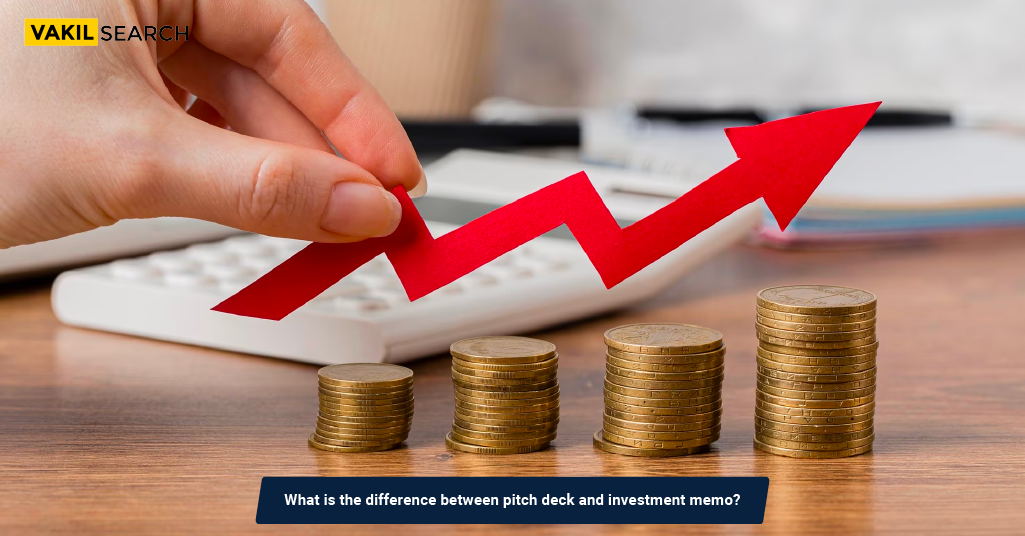Explore the key differences between a pitch deck and an investment memo. Learn about their distinct purposes, structures, content, and target audiences.
Introduction
Startups and entrepreneurs often find themselves navigating the intricate terrain of fundraising, seeking investments to fuel their growth. In this journey, two vital documents play pivotal roles: the pitch deck and the investment memo. While both serve the ultimate goal of securing investments, they are distinctly different in terms of their purpose, structure, content, and audience.
In this article, we will delve deep into the realms of pitch decks and investment memos, while decoding what sets them apart. We’ll also discuss the critical concept of authorized share capital and its significance in both these documents.
Pitch Deck vs. Investment Memo: Definitions and Context
Pitch Deck:
- A pitch deck is a visual presentation that startup founders use to introduce their business to potential investors.
- It is typically delivered during in-person meetings or virtual presentations.
- The aim of a pitch deck is to provide a concise and compelling overview of the startup’s value proposition, market opportunity, team, and financial projections.
- It serves as a tool to spark investor interest and initiate further discussions.
Investment Memo:
- An investment memo, on the other hand, is a written document prepared by investors or their teams.
- It serves as an internal communication tool within the investor’s organization.
- The purpose of an investment memo is to assess the viability of investing in a particular startup.
- It includes a detailed analysis of the startup’s business model, market, competition, risks, and potential returns.
- Investment memos guide investors in making informed decisions about whether to invest or not.
Pitch Deck vs. Investment Memo: Structure and Content
Pitch Deck:
- A pitch deck typically consists of 10-15 slides, each dedicated to a specific aspect of the startup.
- It focuses on key elements like problem statement, solution, market size, business model, traction, team, and financial projections.
- Pitch decks heavily rely on visuals, graphics, and concise text to engage and captivate the audience.
- The information in a pitch deck is concise, emphasizing brevity and impact.
Investment Memo:
- Investment memos are longer, often spanning several pages, and are structured more like a formal report.
- They delve deep into the startup’s industry, competitive landscape, market dynamics, and financial details.
- Investment memos are data-driven documents, that rely on comprehensive analysis and due diligence.
- Investors include their insights, concerns, and recommendations based on the startup’s potential and risks.
Pitch Deck vs. Investment Memo: Audience
Pitch Deck:
- The primary audience for a pitch deck is external – potential investors, venture capitalists, or angel investors.
- This document aims to create a compelling narrative to entice investors into further discussions and negotiations.
Investment Memo:
- Investment memos are strictly internal documents meant for the investment team and decision-makers within an investment firm.
- The objective here is to provide a thorough and objective analysis of the startup’s investment potential to guide the investment decision-making process.
Authorized Share Capital in Pitch Deck and Investment Memo
Pitch Deck:
- Authorized share capital is rarely mentioned in pitch decks.
- The focus here is on presenting the startup’s growth potential, scalability, and market opportunity.
- Investors may inquire about authorized share capital during follow-up discussions.
Investment Memo:
- Authorized share capital holds more significance in investment memos.
- It is important for investors to understand the startup’s capital structure, including the number of authorized shares, issued shares, and their respective classes.
- This information helps investors assess the dilution they might face and their ownership stake post-investment.
How can Vakilsearch Help Startup Founders?
Navigating the complex world of legal documentation and compliance is a critical aspect of startup growth. Vakilsearch specializes in providing legal and compliance services to startups and can assist founders in:
- Structuring and managing their authorized share capital effectively
- Drafting and reviewing pitch decks and investment memos to ensure they meet legal requirements
- Ensuring compliance with regulatory norms during fundraising activities
- Offering expert guidance on legal aspects related to equity, ownership, and investment agreements
Conclusion
In the entrepreneurial journey, securing investments is often a critical milestone, both pitch decks and investment memos play crucial roles in this process. While both aim to facilitate funding, they are distinct in their purpose, structure, content, and audience. Understanding these differences is vital for startup founders and investors alike. Moreover, authorized share capital, though rarely mentioned in pitch decks, holds significant importance in investment memos, guiding investment decisions.
In the dynamic world of startups, having the right legal and compliance support can make all the difference. Vakilsearch can assist startup founders in navigating the complexities of authorized share capital, ensuring that their pitch decks and investment memos align with legal requirements. To know more, reach out to our experts right away!
FAQs
Q1: What is the primary purpose of a pitch deck?
The primary purpose of a pitch deck is to attract potential investors by providing a concise overview of a startup's key aspects and value proposition.
Q2: Who is the audience for an investment memo?
The audience for an investment memo is the internal team within an investment firm, including decision-makers and analysts.
Q3: Why is authorized share capital significant in investment memos?
Authorized share capital is significant in investment memos as it represents the maximum value of shares a company can issue. Investors assess this to gauge potential dilution and future fundraising capacity.
Read more:




